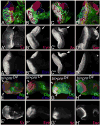Dorsal eye selector pannier (pnr) suppresses the eye fate to define dorsal margin of the Drosophila eye
- PMID: 20691679
- PMCID: PMC2945442
- DOI: 10.1016/j.ydbio.2010.07.030
Dorsal eye selector pannier (pnr) suppresses the eye fate to define dorsal margin of the Drosophila eye
Abstract
Axial patterning is crucial for organogenesis. During Drosophila eye development, dorso-ventral (DV) axis determination is the first lineage restriction event. The eye primordium begins with a default ventral fate, on which the dorsal eye fate is established by expression of the GATA-1 transcription factor pannier (pnr). Earlier, it was suggested that loss of pnr function induces enlargement in the dorsal eye due to ectopic equator formation. Interestingly, we found that in addition to regulating DV patterning, pnr suppresses the eye fate by downregulating the core retinal determination genes eyes absent (eya), sine oculis (so) and dacshund (dac) to define the dorsal eye margin. We found that pnr acts downstream of Ey and affects the retinal determination pathway by suppressing eya. Further analysis of the "eye suppression" function of pnr revealed that this function is likely mediated through suppression of the homeotic gene teashirt (tsh) and is independent of homothorax (hth), a negative regulator of eye. Pnr expression is restricted to the peripodial membrane on the dorsal eye margin, which gives rise to head structures around the eye, and pnr is not expressed in the eye disc proper that forms the retina. Thus, pnr has dual function, during early developmental stages pnr is involved in axial patterning whereas later it promotes the head specific fate. These studies will help in understanding the developmental regulation of boundary formation of the eye field on the dorsal eye margin.
Copyright © 2010 Elsevier Inc. All rights reserved.
Figures








Similar articles
-
A glimpse into dorso-ventral patterning of the Drosophila eye.Dev Dyn. 2012 Jan;241(1):69-84. doi: 10.1002/dvdy.22764. Epub 2011 Oct 27. Dev Dyn. 2012. PMID: 22034010 Free PMC article. Review.
-
Initial state of the Drosophila eye before dorsoventral specification is equivalent to ventral.Development. 2003 Dec;130(25):6351-60. doi: 10.1242/dev.00864. Development. 2003. PMID: 14623824
-
Genetic interaction of Lobe with its modifiers in dorsoventral patterning and growth of the Drosophila eye.Genetics. 2005 Sep;171(1):169-83. doi: 10.1534/genetics.105.044180. Epub 2005 Jun 23. Genetics. 2005. PMID: 15976174 Free PMC article.
-
A vertex specific dorsal selector Dve represses the ventral appendage identity in Drosophila head.Mech Dev. 2014 Aug;133:54-63. doi: 10.1016/j.mod.2014.06.002. Epub 2014 Jun 24. Mech Dev. 2014. PMID: 24971779
-
Retinal determination the beginning of eye development.Curr Top Dev Biol. 2010;93:1-28. doi: 10.1016/B978-0-12-385044-7.00001-1. Curr Top Dev Biol. 2010. PMID: 20959161 Free PMC article. Review.
Cited by
-
Integrative genomic analysis reveals novel regulatory mechanisms of eyeless during Drosophila eye development.Nucleic Acids Res. 2018 Dec 14;46(22):11743-11758. doi: 10.1093/nar/gky892. Nucleic Acids Res. 2018. PMID: 30295802 Free PMC article.
-
A Positive Feedback Loop of Hippo- and c-Jun-Amino-Terminal Kinase Signaling Pathways Regulates Amyloid-Beta-Mediated Neurodegeneration.Front Cell Dev Biol. 2020 Mar 13;8:117. doi: 10.3389/fcell.2020.00117. eCollection 2020. Front Cell Dev Biol. 2020. PMID: 32232042 Free PMC article.
-
Development of the ocellar visual system in Drosophila melanogaster.FEBS J. 2022 Dec;289(23):7411-7427. doi: 10.1111/febs.16468. Epub 2022 May 11. FEBS J. 2022. PMID: 35490409 Free PMC article.
-
Inhibition of Daughterless by Extramacrochaetae mediates Notch-induced cell proliferation.Development. 2015 Jun 1;142(11):2058-68. doi: 10.1242/dev.121855. Epub 2015 May 14. Development. 2015. PMID: 25977368 Free PMC article.
-
The early history of the eye-antennal disc of Drosophila melanogaster.Genetics. 2022 May 5;221(1):iyac041. doi: 10.1093/genetics/iyac041. Genetics. 2022. PMID: 35460415 Free PMC article.
References
-
- Baker NE. Embryonic and imaginal requirements for wingless, a segment-polarity gene in Drosophila. Dev Biol. 1988;125:96–108. - PubMed
-
- Baonza A, Freeman M. Control of Drosophila eye specification by Wingless signalling. Development. 2002;129:5313–5322. - PubMed
-
- Bessa J, Casares F. Restricted teashirt expression confers eye-specific responsiveness to Dpp and Wg signals during eye specification in Drosophila. Development. 2005;132:5011–5020. - PubMed
Publication types
MeSH terms
Substances
Grants and funding
LinkOut - more resources
Full Text Sources
Medical
Molecular Biology Databases

